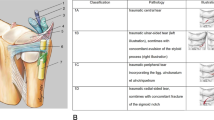Abstract
Purpose
The purpose of this study was to determine functional and subjective results of patients who received arthroscopic debridement for their TFCC Palmer 1B lesions and to compare their results with those of arthroscopic suture repair.
Methods
Between March 2007 and August 2011, 36 patients were diagnosed with Palmer type 1B tears and underwent arthroscopic debridement. 31 patients (15 males and 16 females) were followed up for an average of 26.7 months (±17.4 months) postoperatively. Their average age was 36.7 years (±12.7 years). Follow-up included the determination of range of motion (ROM), grip strength, pain, and wrist scores (modified Mayo wrist score (MMWS), Disabilities of the Arm, Shoulder and Hand questionnaire (DASH score)).
Results
Postoperative ROM averaged 99.2 % for the extension/flexion arc, 95.5 % for the radial/ulnar deviation arc, and 99.4 % for the pronation/supination arc of motion when compared with the contralateral wrist. The MMWS was rated excellent in 48 % of patients, good in 39 %, fair in 13 %, and poor in 0 %. The average DASH score was 17.02 (±14.92). There was a significant reduction in pain. The grip strength was 96.7 % (±15.8), pulp-to-pulp pinch 101.9 % (±17.4), and the ulnar variance −0.12 ± 1.69 mm.
Conclusions
Arthroscopic debridement of Palmer type 1B lesions in stable DRUJ yields satisfactory to excellent results. Our study showed similar results compared with the studies of arthroscopic suture repair with shorter postoperative care and fewer complications.


Similar content being viewed by others
References
Reiter A, Wolf MB, Schmid U et al (2008) Arthroscopic repair of Palmer 1B triangular fibrocartilage complex tears. Arthroscopy 24:1244–1250
Corso SJ, Savoie FH, Geissler WB, Whipple TL, Jiminez W, Jenkins N (1997) Arthroscopic repair of peripheral avulsions of the triangular fibrocartilage complex of the wrist: a multicenter study. Arthroscopy 13:78–84
Palmer AK (1990) Triangular fibrocartilage disorders: injury patterns and treatment. Arthroscopy 6:125–132
Estrella EP, Hung LK, Ho PC, Tse WL (2007) Arthroscopic repair of triangular fibrocartilage complex tears. Arthroscopy 23:729–737
Yao J, Lee AT (2011) All-arthroscopic repair of Palmer 1B triangular fibrocartilage complex tears using the FasT-Fix device. J Hand Surg Am 36:836–842
Wysocki RW, Richard MJ, Crowe MM, Leversedge FJ, Ruch DS (2012) Arthroscopic treatment of peripheral triangular fibrocartilage complex tears with the deep fibers intact. J Hand Surg Am 37:509–516
Moritomo H, Masatomi T, Murase T, Miyake J, Okada K, Yoshikawa H (2010) Open repair of foveal avulsion of the triangular fibrocartilage complex and comparison by types of injury mechanism. J Hand Surg Am 35:1955–1963
Iwasaki N, Minami A (2009) Arthroscopically assisted reattachment of avulsed triangular fibrocartilage complex to the fovea of the ulnar head. J Hand Surg Am 34:1323–1326
Iwasaki N, Nishida K, Motomiya M, Funakoshi T, Minami A (2011) Arthroscopic-assisted repair of avulsed triangular fibrocartilage complex to the fovea of the ulnar head: a 2 to 4-year follow-up study. Arthroscopy 27:1371–1378
Waterman SM, Slade D, Masini BD, Owens BD (2010) Safety analysis of all-inside arthroscopic repair of peripheral triangular fibrocartilage complex. Arthroscopy 26:1474–1477
Atzei A (2009) New trends in arthroscopic management of type 1-B TFCC injuries with DRUJ instability. J Hand Surg Eur 34:582–591
Lubowitz JH, Poehling GG (2008) Keeping up with the literature: knee ligament, wrist triangular fibrocartilage tear, and suture bridge rotator cuff technique questions. Arthroscopy 24:1203–1204
Bain GI, Munt J, Turner PC (2008) New advances in wrist arthroscopy. Arthroscopy 24:355–367
Fujitani R, Omokawa S, Lida A, Santo S, Tanaka Y (2012) Reliability and clinical importance of teardrop angle measurement in intra-articular distal radius fracture. J Hand Surg Am 37:454–459
Ruch DS, Papadonikolakis A (2005) Arthroscopically assisted repair of peripheral triangular fibrocartilage complex tears: factors affecting outcome. Arthroscopy 21:1126–1130
Cooney WP, Bussey R, Dobyns JH, Linscheid RL (1987) Difficult wrist fractures. Perilunate fracture-dislocations of the wrist. Clin Orthop Relat Res 214:136–147
Cooney WP, Linscheid RL, Dobyns JH (1994) Triangular fibrocartilage tears. J Hand Surg Am 19:143–154
Chen W, Wang J, Pan J, Zhang Q, Shao X, Zhang Y (2012) Primary results of Kienböck’s disease treated using balloon kyphoplasty system. Arch Orthop Trauma Surg 132:677–683
Kraus MD, Dehner C, Riepl C, Schöll H, Gebhard F (2012) A novel method of image-based navigation in fracture surgery. Arch Orthop Trauma Surg 132:741–750
Haugstvedt JR, Husby T (1999) Results of repair of peripheral tears in the triangular fibrocartilage complex using an arthroscopic suture technique. Scand J Plast Reconstr Surg Hand Surg 33:439–447
Millants P, De Smet L, Van Ransbeeck H (2002) Outcome study of arthroscopic suturing of ulnar avulsions of the triangular fibrocartilage complex of the wrist. Chir Main 21:298–300
Shih JT, Lee HM, Tan CM (2002) Early isolated triangular fibrocartilage complex tears: management by arthroscopic repair. J Trauma 53:922–927
Tünnerhoff HG, Haussmann P (2001) What are the indications for arthroscopic repair of ulnar tears of the TFCC? Handchir Mikrochir Plast Chir 33:239–244
Conflict of interest
All authors had no financial interest, commercial associations or financial relationships at the time of submission.
Author information
Authors and Affiliations
Corresponding author
Rights and permissions
About this article
Cite this article
Cardenas-Montemayor, E., Hartl, J.F., Wolf, M.B. et al. Subjective and objective results of arthroscopic debridement of ulnar-sided TFCC (Palmer type 1B) lesions with stable distal radio-ulnar joint. Arch Orthop Trauma Surg 133, 287–293 (2013). https://doi.org/10.1007/s00402-012-1643-z
Received:
Published:
Issue Date:
DOI: https://doi.org/10.1007/s00402-012-1643-z




